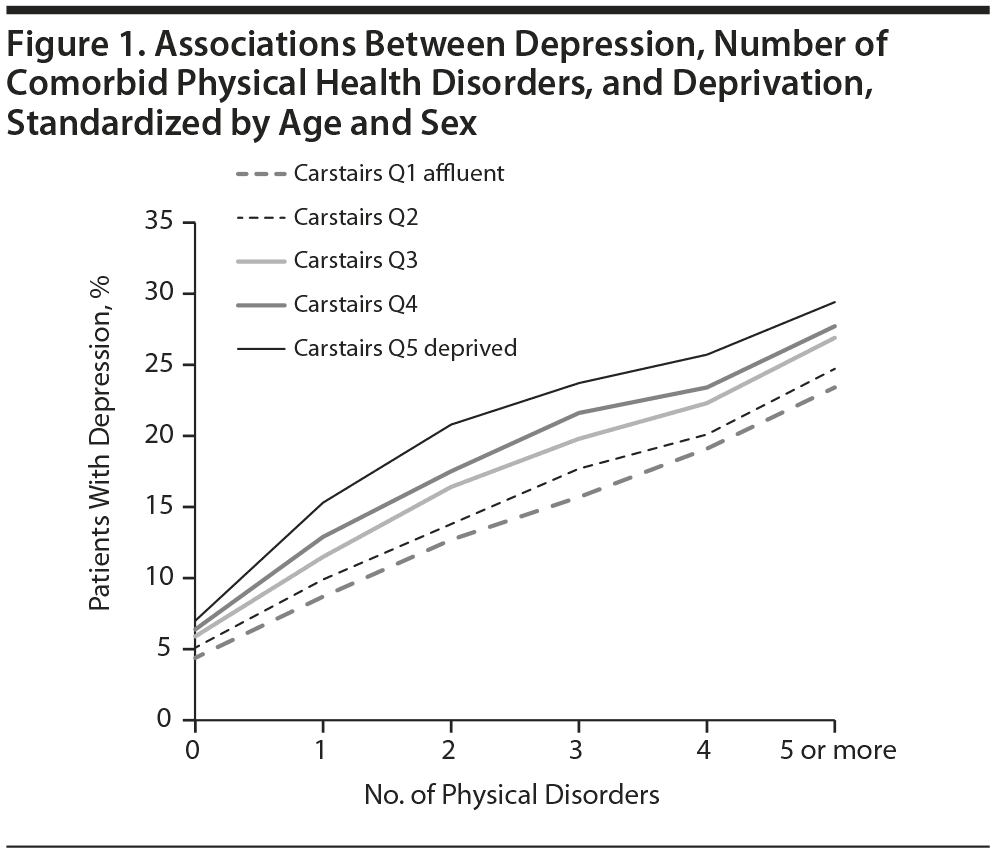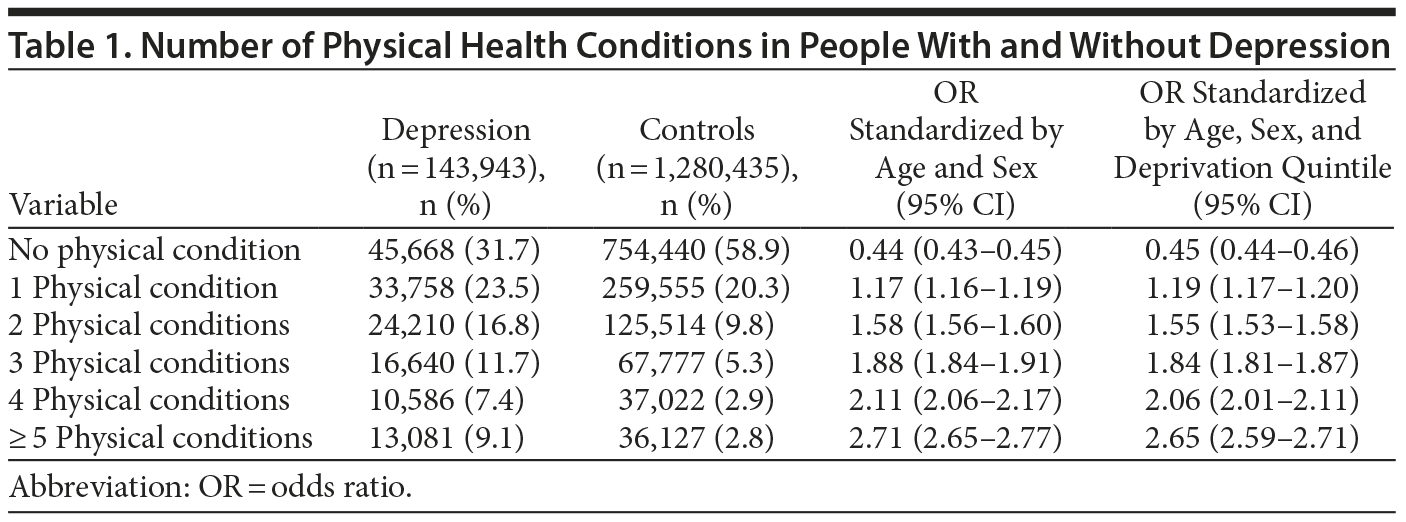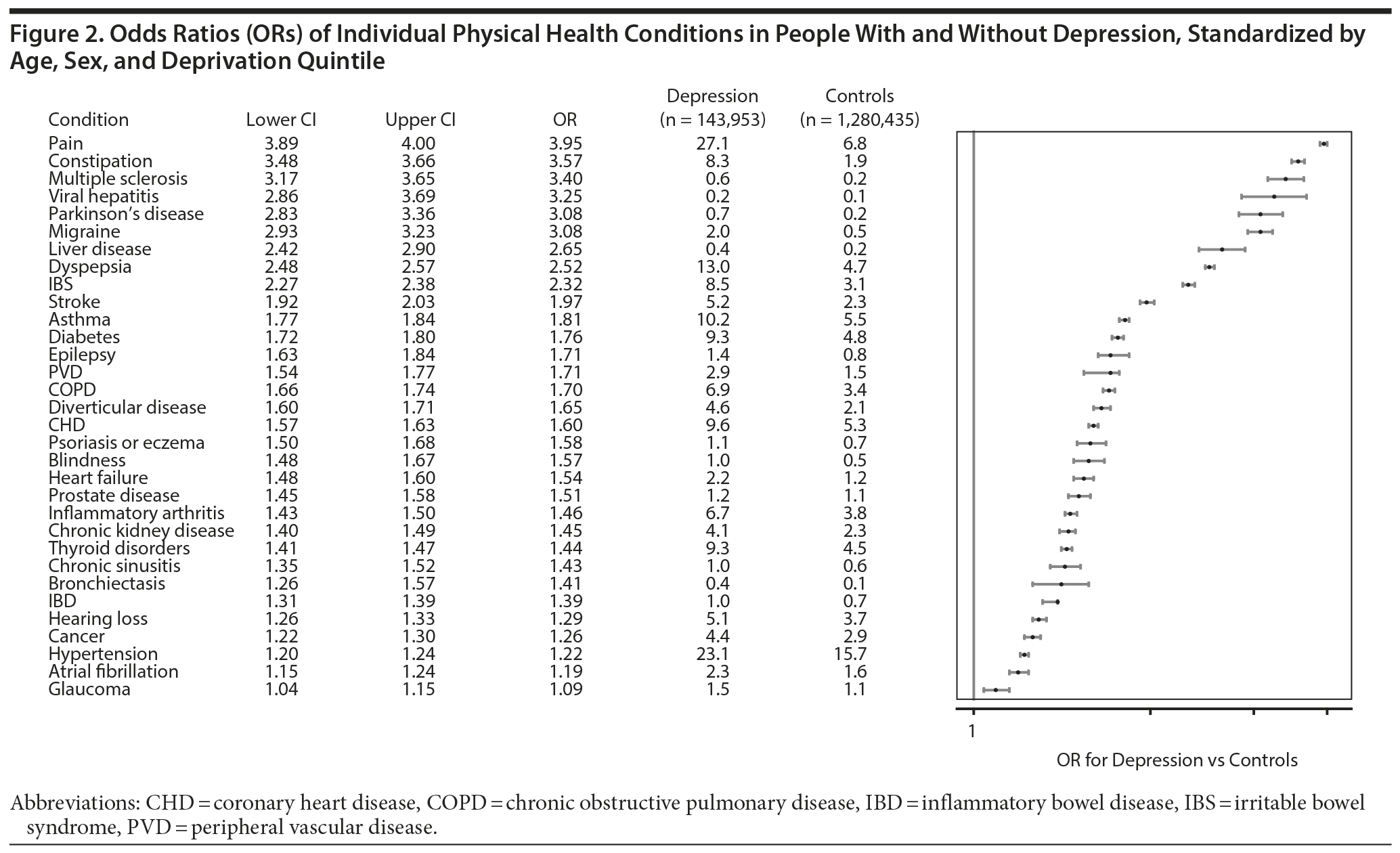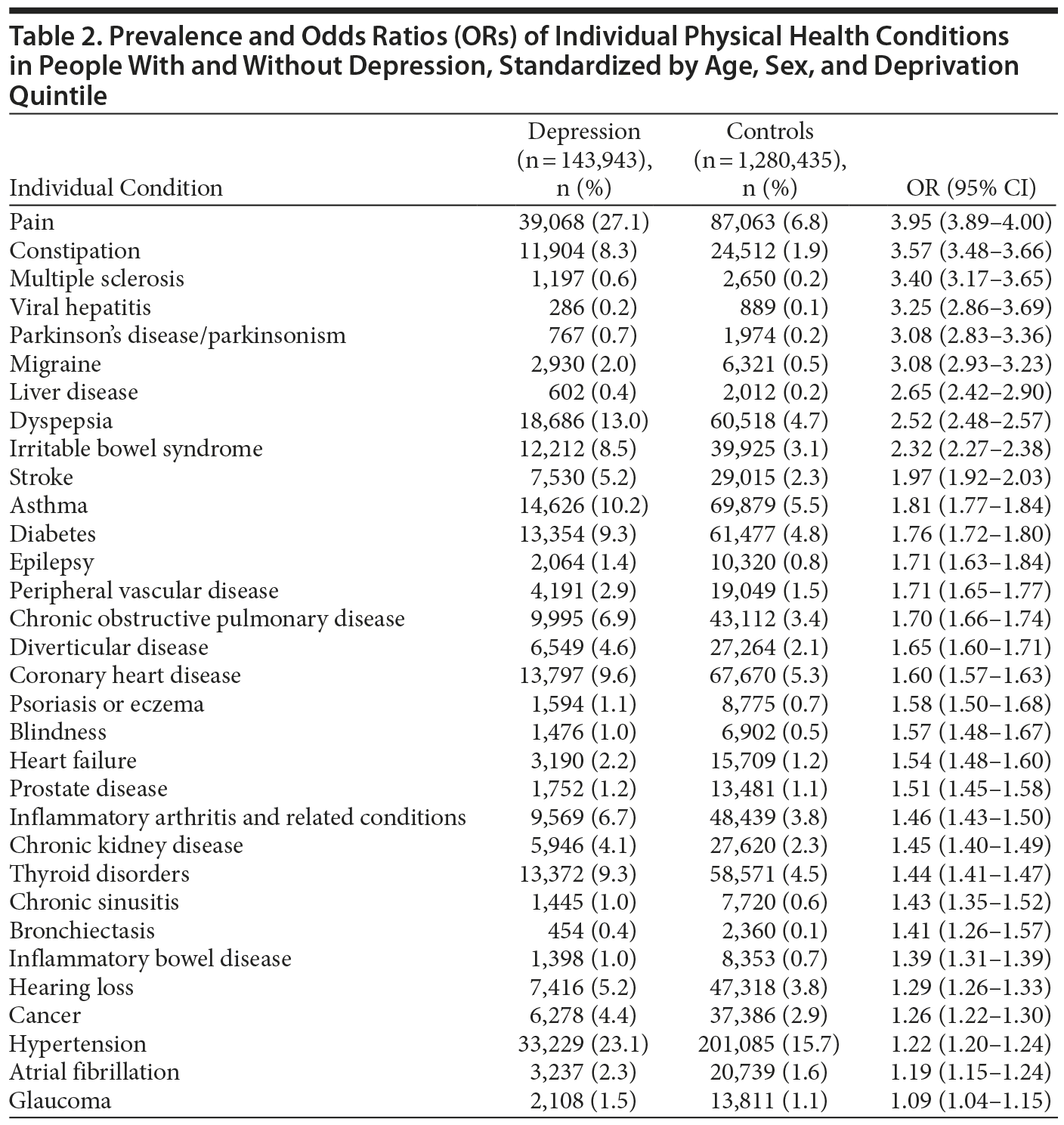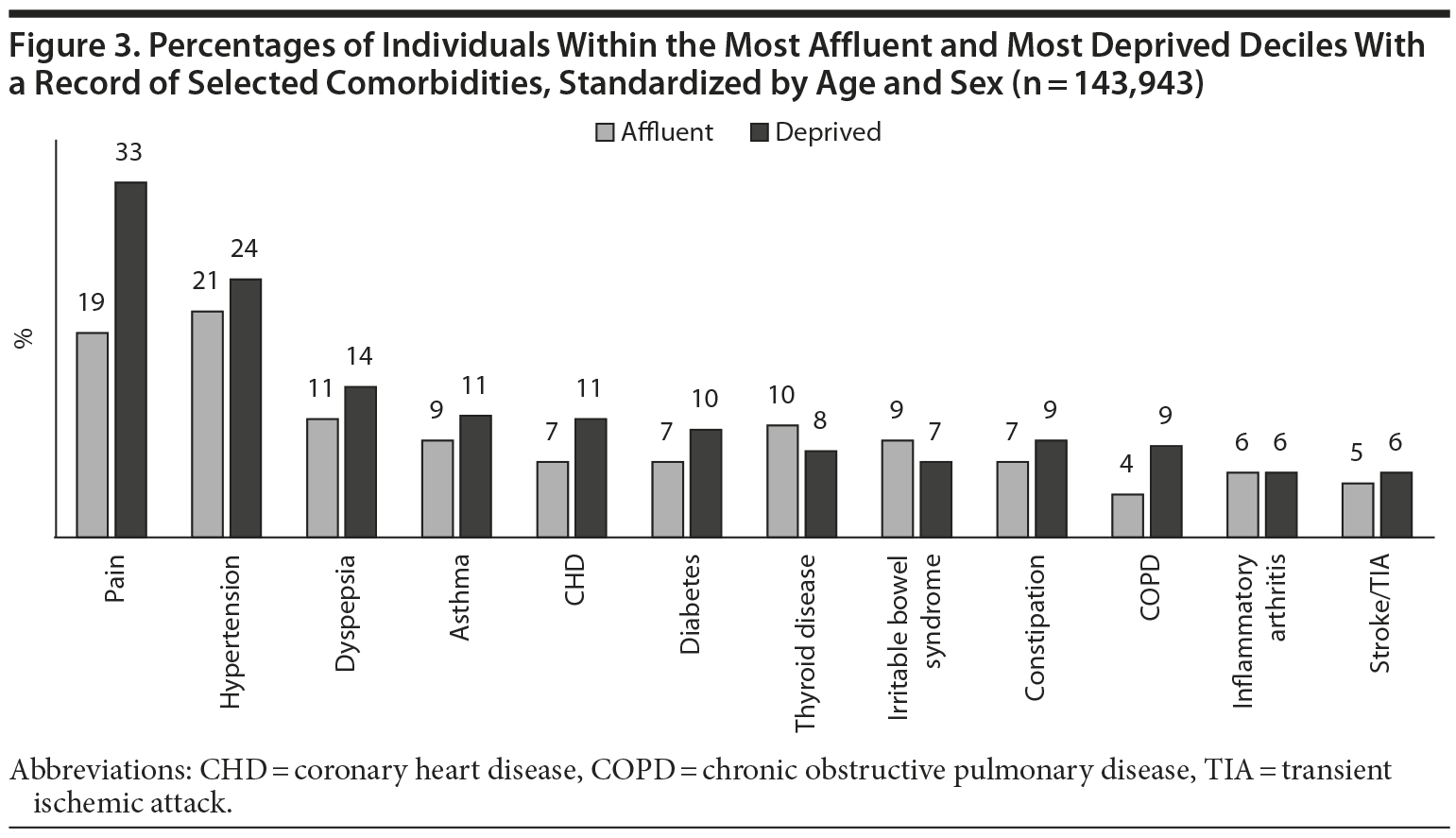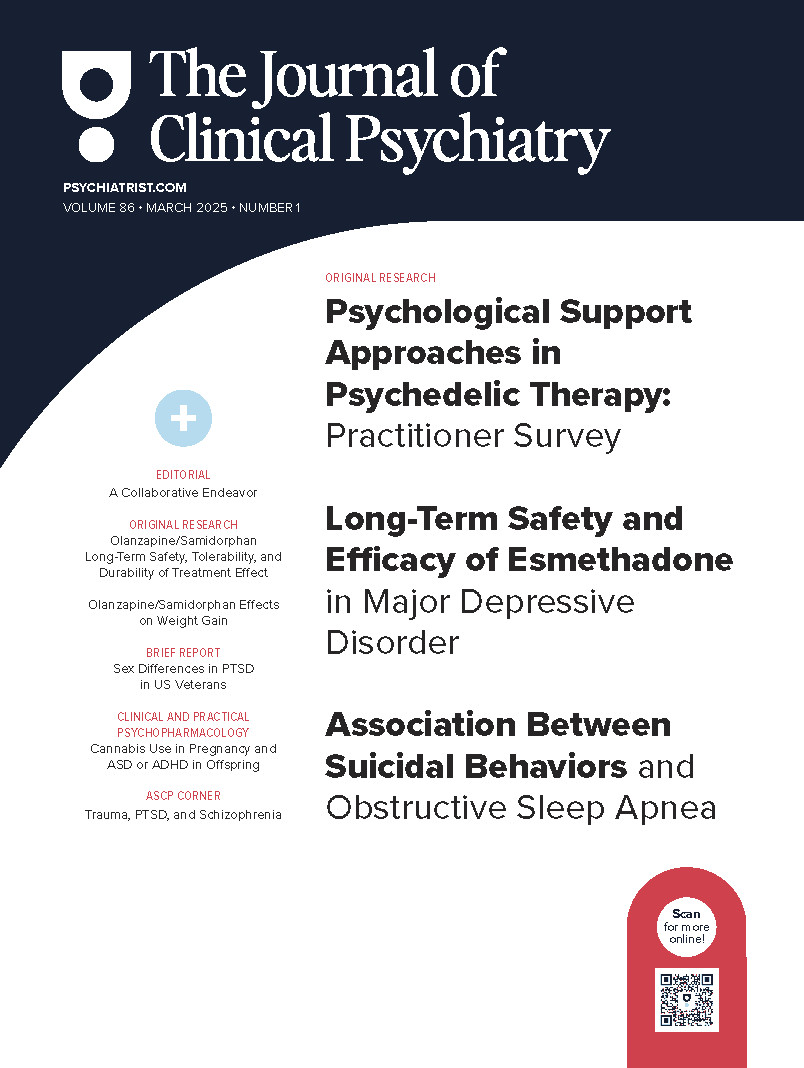See Commentary by O’Dowd.
Background: Depression is common in many chronic physical health disorders, but the nature and extent of physical health comorbidities in depression, particularly within large population-based samples of patients, and how these comorbidities relate to factors such as age, sex, and social deprivation, are unknown. We aimed to assess the nature and extent of multiple physical health comorbidities in primary care patients with depression within a large and representative Scottish dataset.
Method: This study was a cross-sectional secondary data analysis of 314 primary care practices in Scotland (from the Primary Care Clinical Informatics Unit at the University of Aberdeen, Scotland, March 31, 2007), including 143,943 people with depression and 1,280,435 controls. The outcomes assessed were 32 common chronic physical health conditions, adjusted for age, sex, and social deprivation. Depression was defined as a Read code for depression recorded within last year and/or 4 or more antidepressant prescriptions (excluding low-dose tricyclic antidepressants) within the last year.
Results: Individuals in primary care with depression were more likely than individuals without depression to have every one of the 32 comorbid physical conditions we assessed, even after adjusting for age, sex, and deprivation. The depression group was also significantly more likely to have multiple levels of comorbidity, including 2 physical health conditions (OR = 1.55; 95% CI, 1.53-1.58), 3 physical health conditions (OR = 1.84; 95% CI, 1.81-1.87), 4 physical health conditions (OR = 2.06; 95% CI, 2.01-2.11; P < .001), and 5 or more physical health conditions (OR = 2.65; 95% CI, 2.59-2.71; P < .001).
Conclusion: Depression in primary care is associated with a very wide range of physical health comorbidities and considerable medical burden. The nature and extent of this multimorbidity and the important association with social deprivation have not been previously described within a large and representative dataset of routine primary care data. Our findings have important implications for the integrated management of depression and physical health problems in the United Kingdom and throughout the world.


Depression and Multimorbidity: A Cross-Sectional Study of 1,751,841 Patients in Primary Care


ABSTRACT
Background: Depression is common in many chronic physical health disorders, but the nature and extent of physical health comorbidities in depression, particularly within large population-based samples of patients, and how these comorbidities relate to factors such as age, sex, and social deprivation, are unknown. We aimed to assess the nature and extent of multiple physical health comorbidities in primary care patients with depression within a large and representative Scottish dataset.
Method: This study was a cross-sectional secondary data analysis of 314 primary care practices in Scotland (from the Primary Care Clinical Informatics Unit at the University of Aberdeen, Scotland, March 31, 2007), including 143,943 people with depression and 1,280,435 controls. The outcomes assessed were 32 common chronic physical health conditions, adjusted for age, sex, and social deprivation. Depression was defined as a Read code for depression recorded within last year and/or 4 or more antidepressant prescriptions (excluding low-dose tricyclic antidepressants) within the last year.
Results: Individuals in primary care with depression were more likely than individuals without depression to have every one of the 32 comorbid physical conditions we assessed, even after adjusting for age, sex, and deprivation. The depression group was also significantly more likely to have multiple levels of comorbidity, including 2 physical health conditions (OR = 1.55; 95% CI, 1.53-1.58), 3 physical health conditions (OR = 1.84; 95% CI, 1.81-1.87), 4 physical health conditions (OR = 2.06; 95% CI, 2.01-2.11; P < .001), and 5 or more physical health conditions (OR = 2.65; 95% CI, 2.59-2.71; P < .001).
Conclusion: Depression in primary care is associated with a very wide range of physical health comorbidities and considerable medical burden. The nature and extent of this multimorbidity and the important association with social deprivation have not been previously described within a large and representative dataset of routine primary care data. Our findings have important implications for the integrated management of depression and physical health problems in the United Kingdom and throughout the world.
J Clin Psychiatry 2014;75(11):1202-1208
© Copyright 2014 Physicians Postgraduate Press, Inc.
Submitted: March 19, 2014; accepted July 25, 2014 (doi:10.4088/JCP.14m09147).
Corresponding author: Stewart W. Mercer, PhD, Department of Primary Care Research, Institute of Health and Wellbeing, University of Glasgow, 1 Horselethill Rd, Glasgow, G12 9LX ([email protected]).
Depression is a prevalent disorder with a major impact on global public health.1,2 It is well established that depression is associated with a wide range of chronic physical health disorders, such as cardiovascular disease, diabetes, cancer, osteoporosis, and arthritis, and that it has a negative impact on the long-term outcome of these conditions.3-6 Primary care has a central role in the diagnosis and management of depression, particularly when it is comorbid with a chronic physical illness.7 Although it is widely accepted that the relationship between chronic physical health disorders and depression is bidirectional, our understanding of mechanisms underlying these associations is limited. It is also likely that different mechanisms will exist for different physical disorders and for combinations of disorders.
To date, most studies of depression comorbidity have assessed rates of co-occurring depression within index physical health conditions, such as cardiovascular disease,8 diabetes,9 and multiple sclerosis,10 but this approach does not describe the nature and extent of physical health problems within individuals who have a depressive disorder. It is recognized that individuals with chronic physical disorders often have more than 1 disorder11—and that multiple additional physical health conditions interact to affect prognosis—but very little work has assessed rates of multiple physical health problems (multimorbidity) in individuals with depressive disorder.
Here, we take depression as the index condition and describe rates and patterns of comorbidity of 32 common chronic physical health conditions. We also describe rates of multimorbidity for individuals with depression and determine the extent to which this is influenced by factors such as age, sex, and socioeconomic deprivation.
METHOD
We used data from the Primary Care Clinical Informatics Unit at the University of Aberdeen, Scotland, for all 1,751,841 registered patients who were alive and permanently registered with 314 Scottish general practices on March 31, 2007. This dataset is representative of the whole Scottish population in terms of age, sex, and socioeconomic deprivation.7 A more detailed explanation of the dataset is available elsewhere.7
We defined depression as a Read code12 for depression recorded within last year and/or 4 or more antidepressant prescriptions (excluding low-dose tricyclic antidepressants) within the last year. Low-dose tricyclic antidepressants were excluded because they are commonly prescribed for chronic pain syndromes rather than depression. Data on the presence of 32 common chronic physical health conditions were also extracted (listed in Supplementary eTable 1 [available at PSYCHIATRIST.COM]).
Socioeconomic deprivation was measured by using the Carstairs deprivation score divided into quintiles (from most affluent to most deprived). The Carstairs score is based on the postcode of residence and is widely used in health care research.13 Our analyses were restricted to those aged 18 years and over. In line with previous work, the sample was subdivided into the following age groups for analysis: 18 to 24 years, 25 to 34 years, 35 to 44 years, 45 to 54 years, 55 to 64 years, 65 to 74 years, and 75 years and over.


- Multiple medical comorbidities are common in primary care patients with depression, particularly in areas of relative social deprivation.
- The medical treatment burden associated with depression is considerable.
- The treatment of depression requires an integrated approach between primary and secondary care that addresses both mental health and physical health needs of patients.
Differences between individuals with depression (defined using the criteria above) and those without depression (the remainder of the sample, henceforth referred to as controls) were calculated by age, deprivation status, and number of physical conditions. We used t tests to analyze differences between groups and 1-way analysis of variance for differences across age groups and deprivation quintiles. Age- and sex-specific rates were generated by the 7 age groups outlined above and by deprivation quintiles. These age-sex-deprivation standardized rates were then used to calculate odds ratios (ORs) and 95% confidence intervals (CIs) for those with depression compared to those without depression for the prevalence of all 32 physical conditions, as well as no physical disorder, 1 physical condition, 2 physical conditions, 3 physical conditions, 4 physical conditions, and 5 or more physical conditions. For all statistical analyses, a P value less than .05 was considered statistically significant. All analyses were performed in Stata version 13.14 The UK National Health Service National Research Ethics Service approved the anonymous use of these data for research purposes.
RESULTS
Overall, we identified 143,943 people with depression (10.1% of the sample) and 1,280,435 controls. There were differences between the depression group and controls on a wide range of demographic and physical health measures. Individuals with depression were more likely to be female (69.3% vs 48.9%, P < .001) and older (mean = 52.7 years vs 47.5 years, P < .001). They were also more likely to be socially deprived (Carstairs deprivation score: depression group, 0.36; controls, −0.23; P < .001), and there was a consistent gradient in the association between depression, number of physical health comorbidities, and deprivation (Figure 1).
Multimorbidity in Depression Versus Controls
After rates were standardized for age, sex, and deprivation, the depression group was less likely to have no recorded physical conditions (OR = 0.45; 95% CI, 0.44-0.46) and more likely to have 1 physical health condition (OR = 1.19; 95% CI, 1.17-1.20), 2 physical health conditions(OR = 1.55; 95% CI, 1.53-1.58), 3 physical health conditions (OR = 1.84; 95% CI, 1.81-1.87), 4 physical health conditions(OR = 2.06; 95% CI, 2.01-2.11; P < .001), and 5 or more physical health conditions (OR = 2.65; 95% CI, 2.59-2.71; P < .001) (Table 1).
Individual Physical Health Comorbiditiesin Depression Versus Controls
Physical health comorbidities were very common for patients with depression. After standardization of rates for age, sex, and deprivation, people with depression were significantly more likely than controls to have all of the 32 individual physical conditions studied (Figure 2 and Table 2), although it should be noted that the magnitude of these differences was small for some conditions (such as glaucoma, atrial fibrillation, hypertension). Relative comorbidity rates were highest for pain (OR = 3.95; 95% CI, 3.89-4.00), constipation (OR = 3.57; 95% CI, 3.48-3.66), multiple sclerosis (OR = 3.40; 95% CI, 3.17-3.65), viral hepatitis (OR = 3.25; 95% CI, 2.86-3.69), Parkinson’s disease (OR = 3.08; 95% CI, 2.83-3.36), and migraine (OR = 3.08; 95% CI, 2.93-3.23). Sample sizes and ORs for all 32 physical conditions are included within Table 2.
Association Between Social Deprivation and Individual Physical Health Comorbidities in Depression
For the 143,943 patients with depression, there were important differences in the proportion affected by common comorbidities, according to the social deprivation quintile (Figure 3). These comorbidities were more common in the most deprived quintile compared to the most-affluent quintile for 29 of the 32 physical conditions. There was 1 variable (inflammatory arthritis and related disorders) for which no difference between quintiles was found, and there were 2 for which lower rates were found in the most deprived quintile compared with the most affluent (irritable bowel syndrome and thyroid disorders). The biggest differences were found for chronic obstructive pulmonary disease (most-deprived quintile, 9.1%; least deprived, 4.1%; P < .001) and pain (most deprived quintile, 32.9%; least deprived, 19.4%; P < .001).
DISCUSSION
The main finding from this study is that patients with depression within primary care are characterized by high levels of multiple physical comorbidities and that this comorbidity is especially pronounced in areas of greater social deprivation. To some extent, this dose-response relationship between depression and number of physical health comorbidities supports previous work,15,16 but our study adds to the literature by assessing a much wider range of comorbid physical conditions and by assessing associations with age, sex, and levels of social deprivation.
Certain individual conditions—including pain, constipation, multiple sclerosis, viral hepatitis, Parkinson’s disease, and migraine—were statistically significantly many times more likely in individuals with depression relative to individuals without depression. In general, this is consistent with previous research that has identified elevated rates of depressive symptoms and depressive disorders within these conditions.6 Additionally, within the depression group, we found that several chronic conditions (including pain, dyspepsia, asthma, coronary heart disease, diabetes, and chronic obstructive pulmonary disease) were more common in the most deprived quintile compared to the most affluent quintile. In this study, we have not specifically explored how additional comorbid mental health disorders in our depression group, such as anxiety disorders or substance abuse, might influence multimorbidity, but a previous study7 from our group has highlighted the important additive effect of multiple mental health comorbidities on rates of multimorbidity.
Strengths and Limitations
The very large representative sample in this study (almost 1.8 million individuals), the range of physical health conditions assessed, and the capacity to control for age, sex, and social deprivation are all significant strengths of this work, but some limitations are acknowledged. We defined depression in those aged 18 years or older who had a Read code for depression recorded and/or had received antidepressants during a 12-month period, and we excluded individuals on low-dose tricyclic antidepressant therapy (as they were more likely to have a primary pain syndrome) (Appendix 1). A limitation of this definition of depression is that it is based on records that were made by general practitioners rather than objective structured assessments of lifetime major depressive disorder. It is therefore possible that we have failed to detect all of the patients in this sample who would satisfy formal diagnostic criteria for a depressive disorder. However, our finding of 10.1% of the sample satisfying our criteria for depression is broadly consistent with epidemiologic estimates of the 12-month prevalence of depression,17 which we feel represents a reliable definition of clinically diagnosed depression within the dataset. Furthermore, another possible limitation is that a proportion of individuals within our depression group might not have had a Read code for depression and may have been included by virtue of their being on antidepressant medication: for example, individuals with a primary anxiety disorder. Unfortunately, within the data that we have access to, we are not able to separate out such individuals from a more pure depression group.
It is worth noting that this study was not a conventional epidemiologic study but rather a cross-sectional analysis of patients in primary care using diagnostic criteria based on what had been recorded within a primary care database. It is possible that these routine data, collected from 314 primary care practices across Scotland, may contain variability of coding for both depression and the 32 physical health conditions assessed. It is also true that, within the 32 conditions we assessed, there is likely to be some diagnostic heterogeneity, with some conditions (such as coronary heart disease and diabetes) more objectively defined than others (for example, irritable bowel syndrome, and constipation). Patients with depression attending their general practitioner may also commonly present with relatively nonspecific physical symptoms, such as constipation and pain, which are primarily depression related but which may lead to an inflated estimation of these problems as true comorbidities. However, the same patterns were also seen with major physical health conditions like hypertension, coronary heart disease, chronic obstructive pulmonary disease, and diabetes.
It is also the case that the large numbers of cases and controls assessed in this study may have identified some associations that were statistically significant but not necessarily clinically significant: for example, conditions such as glaucoma, atrial fibrillation, and hypertension, which had ORs between 1.09-1.22. Further, we cannot exclude the possibility of some confounding by factors such as different care-seeking behavior and different levels of care quality between practices, but, unfortunately, beyond controlling for social deprivation at the level of the individual patient using the Carstairs measure, we have insufficient practice-level data on these factors to be able to explore them in detail.
Interpretation and Implications
Overall, we found that 68.3% of individuals with depression had at least 1 comorbid physical health condition. Thus, physical health comorbidity appears to be the norm rather than the exception in depressive disorder. This study adds to the literature on the complex interplay between affective disorders and physical health conditions such as cardiovascular disease, diabetes, pain syndromes, and arthritis. It is clearly possible that there may exist some common biological pathways for the development of both physical and mental health disorders, for example, in terms of hypothalamic-pituitary-adrenal axis dysfunction18 and abnormal inflammatory processes,19 but our finding of a robust association between social deprivation, depression, and a wide range of multiple physical health comorbidities also highlights the importance of the social environment in mediating a broad range of adverse health outcomes.
These findings also highlight the significant levels of medical symptom burden (and, by extension, considerable additional health care costs) that are associated with depressive disorders in primary care. Again, this is consistent with some previous work in this area20,21 but extends those findings by identifying that these associations remain significant even when adjusted for age, sex, and levels of social deprivation.
Our findings have important implications for the way in which we should not only conceptualize depressive disorders but also organize health care systems, which will increasingly have to manage large numbers of patients with physical and mental health multimorbidities.22 When people present for management of chronic physical disorders, primary care practitioners need to more actively assess mental health and ensure coordinated management approaches.
In the United Kingdom and similar health care systems, a prevailing model of single disease-focused interventions (and the separation between primary medical care, specialist physical care, and specialist psychiatric care) fails to address this clinical complexity and may contribute to the often disappointing outcomes observed in the treatment of comorbid depressive disorders and physical health conditions. Although there has been progress in this area in recent years (for example, the publication of National Institutes of Health and Clinical Excellence [NICE] guidelines on the treatment of depression in adults with a chronic physical health condition23), a focus on detecting and treating depression in those with chronic physical health disorders needs to be complemented by greater vigilance about the possibility of a wide range of physical health problems in those presenting with depressive symptoms in primary care. The utility of managing multiple problems concurrently rather than according to single-disease approaches is supported by recent work on the effectiveness of collaborative care models for depression and chronic medical comorbidities.6,24
Our findings also have implications for the training of future family doctors and psychiatrists. Specifically, training programs in both areas should focus on issues such as the bidirectional relationship between depression and multiple comorbidities, the complexities of treatment burden, the impact of age and social deprivation on multimorbidity, and the need for more integrated models of care between primary and secondary care settings.
In conclusion, we have identified that depression in primary care is associated with a wider range of multiple physical health problems than has previously been considered and that individuals with multiple physical health problems—especially those living in more deprived social circumstances—have the highest rates of depression. Our findings have important implications for the integrated management of depression and physical health comorbidity within UK primary care, especially at a time of considerable change with respect to the way in which services are organized, commissioned, and delivered. From an international perspective, the correct identification and treatment of multiple medical comorbidities occurring alongside depressive disorders will represent a major challenge for many health care systems around the world.25
Disclosure of off-label usage: The authors have determined that, to the best of their knowledge, no investigational information about pharmaceutical agents that is outside US Food and Drug Administration-approved labeling has been presented in this article.
Author affiliations: Institute of Health and Wellbeing, University of Glasgow (Drs Smith, Court, McLean, D Martin, JL Martin, and Mercer), Mental Health and Wellbeing Research Group, Gartnavel Royal Hospital (Drs Smith, Court, D Martin, and JL Martin), Glasgow; Department of Primary Care Medicine, Quality, Safety and Informatics Research Group, University of Dundee, Dundee (Dr Guthrie), Scotland; and Department of Primary Care Research, General Practice and Primary Health Care Academic Centre, Primary Care Research Unit, Carlton Victoria University of Melbourne, Melbourne, Australia (Dr Gunn).
Author contributions: Drs Guthrie and Mercer conceived the original study design. Dr McLean conducted the analyses. Dr Smith wrote the initial draft, and all authors contributed to subsequent drafts of the manuscript. Dr Mercer is guarantor for the study.
Financial disclosure: Dr Gunn has received grant/research support from the National Health and Medical Research Council and Australian Primary Health Care Institute. Drs Smith, Court, McLean, D Martin, JL Martin, Guthrie, and Mercer have no personal affiliations or financial relationships with any commercial interest to disclose relative to the article.
Funding/support: The authors thank the Chief Scientist Office of the Scottish Government Health Directorates (Applied Research Programme Grant ARPG/07/01), who funded the work; the Scottish School of Primary Care, who part supported Dr Mercer’s post and a Visiting Professor Award to Dr Gunn with the University of Glasgow; and the Primary Care Clinical Informatics Unit at the University of Aberdeen, who provided the data contained herein.
Role of the sponsors: The study sponsors had no role in the design and conduct of the study; collection, management, analysis, and interpretation of the data; and preparation, review, or approval of the manuscript.
Disclaimer: The views in this publication are not necessarily the views of the University of Aberdeen, its agents, or employees.
Acknowledgments: The authors thank Katie Wilde, MMaths, and Fiona Chaloner, BSc, of the University of Aberdeen, who did the initial data extraction and management. Mss Wilde and Chaloner have no conflicts of interest to report.
Additional information: Further information about the database used in the study (Primary Care Clinical Informatics Unit at the University of Aberdeen) can be obtained from Dr Mercer: [email protected]
Supplementary material: Available at PSYCHIATRIST.COM.
REFERENCES
1. Murray CJL, Richards MA, Newton JN, et al. UK health performance: findings of the Global Burden of Disease Study 2010. Lancet. 2013;381(9871):997-1020. PubMed doi:10.1016/S0140-6736(13)60355-4
2. Whiteford HA, Degenhardt L, Rehm J, et al. Global burden of disease attributable to mental and substance use disorders: findings from the Global Burden of Disease Study 2010. Lancet. 2013;382(9904):1575-1586. PubMed doi:10.1016/S0140-6736(13)61611-6
3. Moussavi S, Chatterji S, Verdes E, et al. Depression, chronic diseases, and decrements in health: results from the World Health Surveys. Lancet. 2007;370(9590):851-858. PubMed doi:10.1016/S0140-6736(07)61415-9
4. Stommel M, Given BA, Given CW. Depression and functional status as predictors of death among cancer patients. Cancer. 2002;94(10):2719-2727. PubMed doi:10.1002/cncr.10533
5. Michelson D, Stratakis C, Hill L, et al. Bone mineral density in women with depression. N Engl J Med. 1996;335(16):1176-1181. PubMed doi:10.1056/NEJM199610173351602
6. Katon WJ. Epidemiology and treatment of depression in patients with chronic medical illness. Dialogues Clin Neurosci. 2011;13(1):7-23. PubMed
7. Barnett K, Mercer SW, Norbury M, et al. Epidemiology of multimorbidity and implications for health care, research, and medical education: a cross-sectional study. Lancet. 2012;380(9836):37-43. PubMed doi:10.1016/S0140-6736(12)60240-2
8. Chauvet-Gélinier J-C, Trojak B, Vergרs-Patois B, et al. Review on depression and coronary heart disease. Arch Cardiovasc Dis. 2013;106(2):103-110. PubMed doi:10.1016/j.acvd.2012.12.004
9. Mommersteeg PMC, Herr R, Pouwer F, et al. The association between diabetes and an episode of depressive symptoms in the 2002 World Health Survey: an analysis of 231,797 individuals from 47 countries. Diabet Med. 2013;30(6):e208-e214. PubMed doi:10.1111/dme.12193
10. Siegert RJ, Abernethy DA. Depression in multiple sclerosis: a review. J Neurol Neurosurg Psychiatry. 2005;76(4):469-475. PubMed doi:10.1136/jnnp.2004.054635
11. van den Akker M, Buntinx F, Metsemakers JF, et al. Multimorbidity in general practice: prevalence, incidence, and determinants of co-occurring chronic and recurrent diseases. J Clin Epidemiol. 1998;51(5):367-375. PubMed doi:10.1016/S0895-4356(97)00306-5
12. Chisholm J. The Read clinical classification. BMJ. 1990;300(6732):1092. PubMed doi:10.1136/bmj.300.6732.1092
13. Carstairs V, Morris R. Deprivation and Health in Scotland. Aberdeen, Scotland: Aberdeen University Press; 1991.
14. Stata Statistical Software: Release 12.1 [computer program]. College Station, TX: StataCorp; 2011.
15. Gunn JM, Ayton DR, Densley K, et al. The association between chronic illness, multimorbidity and depressive symptoms in an Australian primary care cohort. Soc Psychiatry Psychiatr Epidemiol. 2012;47(2):175-184. PubMed doi:10.1007/s00127-010-0330-z
16. Wong SY, Mercer SW, Woo J, et al. The influence of multi-morbidity and self-reported socio-economic standing on the prevalence of depression in an elderly Hong Kong population. BMC Public Health. 2008;8(1):119. PubMed doi:10.1186/1471-2458-8-119
17. Kessler RC, Angermeyer M, Anthony JC, et al. Lifetime prevalence and age-of-onset distributions of mental disorders in the world health organization’s world mental health survey initiative. World Psychiatry. 2007;6(3):168-176. PubMed
18. Krishnan V, Nestler EJ. The molecular neurobiology of depression. Nature. 2008;455(7215):894-902. PubMed doi:10.1038/nature07455
19. Berk M, Williams LJ, Jacka FN, et al. So depression is an inflammatory disease, but where does the inflammation come from? BMC Med. 2013;11(1):200. PubMed
20. Leong IYFM, Farrell MJ, Helme RD, et al. The relationship between medical comorbidity and self-rated pain, mood disturbance, and function in older people with chronic pain. J Gerontol A Biol Sci Med Sci. 2007;62(5):550-555. PubMed doi:10.1093/gerona/62.5.550
21. Lyness JMDP, Duberstein PR, King DA, et al. Medical illness burden, trait neuroticism, and depression in older primary care patients. Am J Psychiatry. 1998;155(7):969-971. PubMed
22. Langan J, Mercer SW, Smith DJ. Multimorbidity and mental health: can psychiatry rise to the challenge? Br J Psychiatry. 2013;202(6):391-393. PubMed doi:10.1192/bjp.bp.112.123943
23. National Collaborating Centre for Mental Health (UK). Depression in Adults With a Chronic Physical Health Problem: Treatment and Management. Clinical Guideline 91. Leicester, UK: British Psychological Society; 2010.
24. Katon WJ, Lin EHB, Von Korff M, et al. Collaborative care for patients with depression and chronic illnesses. N Engl J Med. 2010;363(27):2611-2620. PubMed doi:10.1056/NEJMoa1003955
25. Collins PY, Patel V, Joestl SS, et al; Scientific Advisory Board and the Executive Committee of the Grand Challenges on Global Mental Health. Grand challenges in global mental health. Nature. 2011;475(7354):27-30. PubMed doi:10.1038/475027a
This PDF is free for all visitors!
